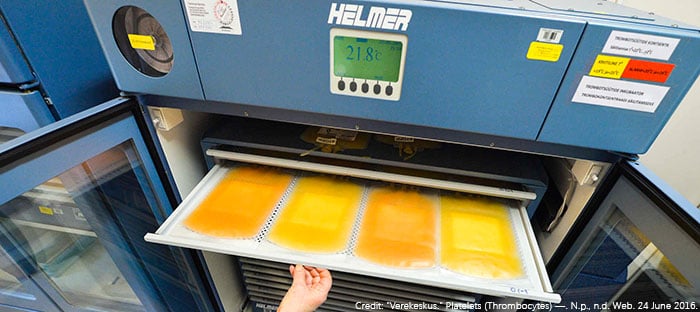
Each blood component has specific storage requirements. Platelet products are unique because they must be stored at room temperature (20ºC to 24ºC) with continuous, gentle agitation, whereas other blood products are stored at colder temperatures. An unfortunate consequence of room temperature storage is the risk of bacterial growth within the stored product. The results of transfusing a contaminated platelet product are severe, leading to transfusion-transmitted sepsis and in some cases an immediate fatal outcome. (While there is ongoing research into cold storage of platelets, this has not been implemented because of the concern that platelets stored under colder conditions are cleared too rapidly from the patient’s blood stream.)
History
In the past, room temperature storage has meant the shelf-life for platelet products has been restricted to 5 days. This very limited window of time is intended to reduce the risk of bacterial proliferation. Starting in 2004, a culture–based bacterial detection process was implemented by U.S. blood centers to reduce the risk of transfusing contaminated platelets. In 2005, it was thought that the implementation of bacterial detection sufficiently reduced the risk, and the shelf-life for platelets was extended from 5 to 7 days. For additional risk mitigation, a surveillance study was conducted to confirm that 7-day platelets, when tested early in storage, presented no greater risk of bacterial contamination than untested 5-day platelets. Findings from this study indicated that, while culture-based testing detects some instances of contamination, not all true positives are identified. Therefore, in 2008 the study ended and the shelf life for platelet products reverted back to 5 days.
Why Does Shelf Life Matter?
The critical testing conducted by blood centers, which includes infectious disease testing as well as bacterial detection for platelets, consumes a day or two of the platelet unit’s shelf life. This does not leave very much time for these units to be shipped to hospitals and transfused to patients who need them. Unfortunately, this means that platelets tend to have higher expiration rates compared to other blood products, which is problematic because they are a precious resource in terms of both therapeutic benefits and cost.
Recent Positive Developments
The FDA has cleared two 7-day storage containers as well as a secondary safety test. The secondary test is a critical safety measure performed at the hospital within a 24 hour window prior to a platelet transfusion. It prevents the transfusion of contaminated units which are not detected by the culture-based method used soon after collection. These clearances have paved the way for 7-day platelets to become a reality again, enhancing patient safety and saving the U.S. healthcare system millions of dollars annually. The FDA recently published Draft Guidance on Bacterial Risk Control Strategies for Blood Collection Establishments and Transfusion Services to Enhance the Safety and Availability of Platelets for Transfusion. This guidance document provides recommendations on how to control the risk of bacterial contamination for platelets stored at room temperature and includes information on extending the expiration date to 7-days.
Supporting Your Platelet Storage
At Helmer Scientific, we are always pleased with developments that positively impact our customers and the patients they care for. We have offered high quality platelet storage equipment for 40 years and are thrilled to hear about new advances that improve the availability of this precious, life-giving resource. We are here to support your efforts to properly store and monitor your platelet products.
You can find more information on Helmer products for Transfusion Services and Blood Centers on our website.
Image: "Verekeskus." Platelets (Thrombocytes) —. N.p., n.d. Web. 24 June 2016.



